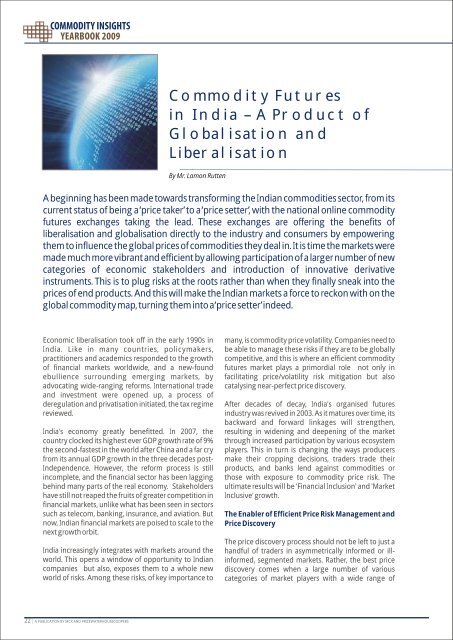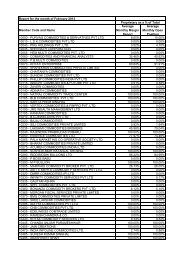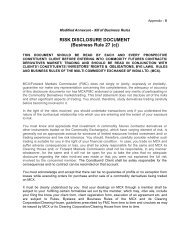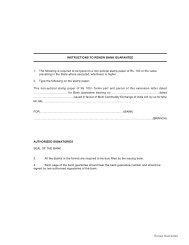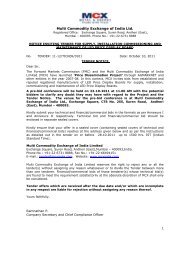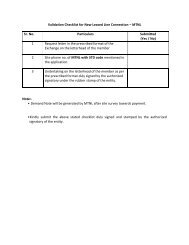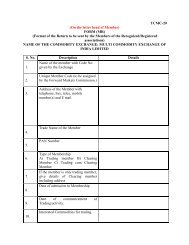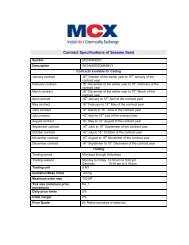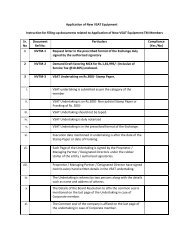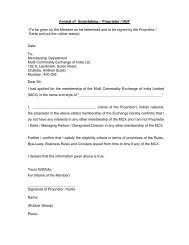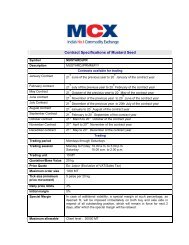Commodity Futures in India â A Product of ... - MCX in Marathi
Commodity Futures in India â A Product of ... - MCX in Marathi
Commodity Futures in India â A Product of ... - MCX in Marathi
You also want an ePaper? Increase the reach of your titles
YUMPU automatically turns print PDFs into web optimized ePapers that Google loves.
<strong>Commodity</strong> <strong>Futures</strong><br />
<strong>in</strong> <strong>India</strong> – A <strong>Product</strong> <strong>of</strong><br />
Globalisation and<br />
Liberalisation<br />
By Mr. Lamon Rutten<br />
A beg<strong>in</strong>n<strong>in</strong>g has been made towards transform<strong>in</strong>g the <strong>India</strong>n commodities sector, from its<br />
current status <strong>of</strong> be<strong>in</strong>g a ‘price taker’ to a ‘price setter’, with the national onl<strong>in</strong>e commodity<br />
futures exchanges tak<strong>in</strong>g the lead. These exchanges are <strong>of</strong>fer<strong>in</strong>g the benefits <strong>of</strong><br />
liberalisation and globalisation directly to the <strong>in</strong>dustry and consumers by empower<strong>in</strong>g<br />
them to <strong>in</strong>fluence the global prices <strong>of</strong> commodities they deal <strong>in</strong>. It is time the markets were<br />
made much more vibrant and efficient by allow<strong>in</strong>g participation <strong>of</strong> a larger number <strong>of</strong> new<br />
categories <strong>of</strong> economic stakeholders and <strong>in</strong>troduction <strong>of</strong> <strong>in</strong>novative derivative<br />
<strong>in</strong>struments. This is to plug risks at the roots rather than when they f<strong>in</strong>ally sneak <strong>in</strong>to the<br />
prices <strong>of</strong> end products. And this will make the <strong>India</strong>n markets a force to reckon with on the<br />
global commodity map, turn<strong>in</strong>g them <strong>in</strong>to a ‘price setter’ <strong>in</strong>deed.<br />
Economic liberalisation took <strong>of</strong>f <strong>in</strong> the early 1990s <strong>in</strong><br />
<strong>India</strong>. Like <strong>in</strong> many countries, policymakers,<br />
practitioners and academics responded to the growth<br />
<strong>of</strong> f<strong>in</strong>ancial markets worldwide, and a new-found<br />
ebullience surround<strong>in</strong>g emerg<strong>in</strong>g markets, by<br />
advocat<strong>in</strong>g wide-rang<strong>in</strong>g reforms. International trade<br />
and <strong>in</strong>vestment were opened up, a process <strong>of</strong><br />
deregulation and privatisation <strong>in</strong>itiated, the tax regime<br />
reviewed.<br />
<strong>India</strong>'s economy greatly benefitted. In 2007, the<br />
country clocked its highest ever GDP growth rate <strong>of</strong> 9%<br />
the second-fastest <strong>in</strong> the world after Ch<strong>in</strong>a and a far cry<br />
from its annual GDP growth <strong>in</strong> the three decades post-<br />
Independence. However, the reform process is still<br />
<strong>in</strong>complete, and the f<strong>in</strong>ancial sector has been lagg<strong>in</strong>g<br />
beh<strong>in</strong>d many parts <strong>of</strong> the real economy. Stakeholders<br />
have still not reaped the fruits <strong>of</strong> greater competition <strong>in</strong><br />
f<strong>in</strong>ancial markets, unlike what has been seen <strong>in</strong> sectors<br />
such as telecom, bank<strong>in</strong>g, <strong>in</strong>surance, and aviation. But<br />
now, <strong>India</strong>n f<strong>in</strong>ancial markets are poised to scale to the<br />
next growth orbit.<br />
<strong>India</strong> <strong>in</strong>creas<strong>in</strong>gly <strong>in</strong>tegrates with markets around the<br />
world. This opens a w<strong>in</strong>dow <strong>of</strong> opportunity to <strong>India</strong>n<br />
companies but also, exposes them to a whole new<br />
world <strong>of</strong> risks. Among these risks, <strong>of</strong> key importance to<br />
many, is commodity price volatility. Companies need to<br />
be able to manage these risks if they are to be globally<br />
competitive, and this is where an efficient commodity<br />
futures market plays a primordial role not only <strong>in</strong><br />
facilitat<strong>in</strong>g price/volatility risk mitigation but also<br />
catalys<strong>in</strong>g near-perfect price discovery.<br />
After decades <strong>of</strong> decay, <strong>India</strong>'s organised futures<br />
<strong>in</strong>dustry was revived <strong>in</strong> 2003. As it matures over time, its<br />
backward and forward l<strong>in</strong>kages will strengthen,<br />
result<strong>in</strong>g <strong>in</strong> widen<strong>in</strong>g and deepen<strong>in</strong>g <strong>of</strong> the market<br />
through <strong>in</strong>creased participation by various ecosystem<br />
players. This <strong>in</strong> turn is chang<strong>in</strong>g the ways producers<br />
make their cropp<strong>in</strong>g decisions, traders trade their<br />
products, and banks lend aga<strong>in</strong>st commodities or<br />
those with exposure to commodity price risk. The<br />
ultimate results will be 'F<strong>in</strong>ancial Inclusion' and 'Market<br />
Inclusive' growth.<br />
The Enabler <strong>of</strong> Efficient Price Risk Management and<br />
Price Discovery<br />
The price discovery process should not be left to just a<br />
handful <strong>of</strong> traders <strong>in</strong> asymmetrically <strong>in</strong>formed or ill<strong>in</strong>formed,<br />
segmented markets. Rather, the best price<br />
discovery comes when a large number <strong>of</strong> various<br />
categories <strong>of</strong> market players with a wide range <strong>of</strong><br />
22 | A PUBLICATION BY <strong>MCX</strong> AND PRICEWATERHOUSECOOPERS
objectives and <strong>in</strong>terests converge on an organized<br />
futures platform. Such a platform and the Multi<br />
<strong>Commodity</strong> Exchange <strong>of</strong> <strong>India</strong> Ltd. (<strong>MCX</strong>) is one<br />
ensures that all relevant <strong>in</strong>formation is absorbed <strong>in</strong> the<br />
price formation process, and the “right price” is<br />
discovered. The more efficient the discovered prices on<br />
a futures platform is, the more effective are the<br />
bus<strong>in</strong>ess and policy decisions that are taken based on<br />
these prices.<br />
The efficiency and transparency <strong>of</strong> price discovery<br />
depends on the robustness <strong>of</strong> the trad<strong>in</strong>g platform; its<br />
regulations; the right mix <strong>of</strong> its participants with<br />
relevant price <strong>in</strong>formation; mak<strong>in</strong>g participation costeffective<br />
vis-à-vis alternatives available for risk<br />
management and/or <strong>in</strong>vestment; effec tive<br />
management <strong>of</strong> the participants' varied risks and, last<br />
but not the least, a robust and transparent clear<strong>in</strong>g<br />
policy.<br />
In just about six years, the national commodity futures<br />
exchanges <strong>in</strong> <strong>India</strong> performed better than the<br />
policymakers expected <strong>in</strong> terms <strong>of</strong> catch<strong>in</strong>g up with<br />
their age-old global counterparts on most <strong>of</strong> the<br />
aforesaid parameters. A lot <strong>of</strong> efforts delivered from a<br />
base <strong>of</strong> strong doma<strong>in</strong> knowledge and technical skills<br />
went beh<strong>in</strong>d this spectacular growth. Selection <strong>of</strong><br />
commodities relevant to the stakeholders; right<br />
contract design; keep<strong>in</strong>g ears and eyes to market<br />
needs; tak<strong>in</strong>g them to appropriate participants;<br />
creat<strong>in</strong>g awareness; expand<strong>in</strong>g <strong>in</strong>frastructure; and<br />
br<strong>in</strong>g<strong>in</strong>g <strong>in</strong> world-class technology and global best<br />
practices are some worth mention<strong>in</strong>g.<br />
To make these markets more relevant and useful to<br />
different categories <strong>of</strong> stakeholders and thus their<br />
participation more effective, it is necessary that various<br />
risks to the participants be effectively managed. Risk<br />
management tools on a futures platform <strong>in</strong>clude<br />
marg<strong>in</strong><strong>in</strong>g, limits on open positions, and effective<br />
surveillance (see table 1). Price volatility <strong>of</strong><br />
commodities traded on an exchange is an <strong>in</strong>dicator <strong>of</strong><br />
how effectively these tools are used by the exchange<br />
managers to improve the efficiency <strong>of</strong> price discovery.<br />
That is to gauge the capability <strong>of</strong> its futures contracts to<br />
predict its maturity prices more accurately (<strong>in</strong>dicated<br />
by the percentage deviation between the first traded<br />
price and the last traded price <strong>of</strong> a given contract). The<br />
efficiency <strong>of</strong> price discovery is also <strong>in</strong>dicated by the<br />
nearness <strong>of</strong> the spot and futures price movements. In<br />
the case <strong>of</strong> <strong>MCX</strong>, the correlation between its gold<br />
futures contract and gold spot prices is around 99.8%<br />
(from January 2007 to August 2009), which <strong>in</strong>dicates a<br />
strong <strong>in</strong>ter-l<strong>in</strong>kage between domestic spot and<br />
futures markets. For the same period, <strong>MCX</strong> gold<br />
contract's correlation with the global benchmark,<br />
COMEX gold futures contract, is around 99.9% (the<br />
rupee adjusted). This reflects how efficient the <strong>India</strong>n<br />
futures market is <strong>in</strong> captur<strong>in</strong>g global cues.<br />
Table 1: <strong>MCX</strong> vis-à-vis global parameters<br />
Particulars<br />
Domestic Exchanges<br />
<strong>Commodity</strong><br />
exchange (<strong>MCX</strong>)<br />
Stock<br />
exchange (NSE)<br />
Global Exchanges<br />
COMEX<br />
and CBOT<br />
Remarks<br />
Position limit to<br />
physical market<br />
size (%)<br />
Gold - 0.9%<br />
-<br />
COMEX Gold - 18.7%<br />
Position limit is significantly lower than that<br />
<strong>of</strong> global benchmark exchanges <strong>in</strong>dicat<strong>in</strong>g<br />
that the domestic futures market cannot be<br />
distorted by s<strong>in</strong>gle/a few players.<br />
Avg. daily volatility<br />
<strong>in</strong> January 2007<br />
to August 2009<br />
Gold - 1.3%,<br />
Ref. Soy Oil - 1.2%<br />
<strong>MCX</strong> Comdex<br />
- 1.4%.<br />
NIFTY - 1.60%<br />
COMEX Gold - 1.5%<br />
CBOT Soybean Oil<br />
- 2.1%<br />
The lower price volatility on <strong>MCX</strong> compared<br />
with global exchanges reflects that price<br />
discovery on the domestic platform is<br />
happen<strong>in</strong>g with more price stability.<br />
Impact cost<br />
Gold - 0.027%<br />
NIFTY - 0.16%<br />
COMEX Gold - 0.019%<br />
The lower impact cost on <strong>MCX</strong> at par with<br />
global exchanges reflects better liquidity <strong>in</strong><br />
terms <strong>of</strong> market depth and width.<br />
Note: In the case <strong>of</strong> price discovery, we considered August 2009 contracts – <strong>MCX</strong> Gold contract, COMEX Gold and Nifty <strong>Futures</strong>.<br />
Impact cost <strong>of</strong> the S&P CNX Nifty for a portfolio size <strong>of</strong> Rs.2 crore sourced from NSE website on September 9, 2009.<br />
Impact cost for Nifty was calculated based on trad<strong>in</strong>g happened on a regular trad<strong>in</strong>g day. Impact cost <strong>of</strong> <strong>MCX</strong> gold calculated for a portfolio size <strong>of</strong> Rs.2 crore.<br />
Impact cost <strong>of</strong> COMEX Gold calculated for a portfolio <strong>of</strong> USD4 lakh (app. Rs.2 crore).<br />
EXPERTS’ VIEWS | 23
Aga<strong>in</strong>, as the same table shows, <strong>MCX</strong> gold contract is<br />
more efficient than COMEX gold contract <strong>in</strong> terms <strong>of</strong><br />
price discovery. The lower volatility on the <strong>India</strong>n<br />
commodity exchanges is due to the close monitor<strong>in</strong>g<br />
and the robust marg<strong>in</strong><strong>in</strong>g system adopted by them.<br />
<strong>MCX</strong> follows strict vigilance with an automated system<br />
<strong>in</strong> place. The system, for example, provides automated<br />
alerts when a member’s marg<strong>in</strong> utilization crosses<br />
various levels. If the marg<strong>in</strong> utilization crosses 100%,<br />
the member <strong>in</strong> question is put automatically on a<br />
“square <strong>of</strong>f” mode. This <strong>in</strong>novative risk management<br />
system has been adopted to prevent any spread <strong>of</strong><br />
f<strong>in</strong>ancial contagion. Besides the functional efficiency <strong>of</strong><br />
trad<strong>in</strong>g, the technological robustness (both hardware<br />
and s<strong>of</strong>tware) also adds value to the <strong>MCX</strong> participants<br />
by enabl<strong>in</strong>g cost reduction. It has a constant<br />
collaboration with FTIL, the parent company, aimed at<br />
improv<strong>in</strong>g the s<strong>of</strong>tware through telecom technology,<br />
and this works towards cost-effectively connect<strong>in</strong>g the<br />
stakeholders to the market.<br />
<strong>Commodity</strong> Derivatives - the Road So Far<br />
The <strong>in</strong>troduction <strong>of</strong> commodity derivatives has<br />
rema<strong>in</strong>ed one <strong>of</strong> the most significant developments <strong>in</strong><br />
the <strong>India</strong>n commodity market sector. The three<br />
national onl<strong>in</strong>e exchanges brought <strong>in</strong> revolutionary<br />
changes <strong>in</strong> this sector by br<strong>in</strong>g<strong>in</strong>g <strong>in</strong> spatial <strong>in</strong>tegration<br />
and temporal price discovery <strong>of</strong> commodities at the<br />
national level. In the span <strong>of</strong> just six years, they have<br />
performed well, be<strong>in</strong>g successful <strong>in</strong> br<strong>in</strong>g<strong>in</strong>g various<br />
ecosystem participants such as producers, hedgers,<br />
arbitragers, and speculators on to a s<strong>in</strong>gle platform. The<br />
annual turnover <strong>of</strong> domestic commodity exchanges<br />
<strong>in</strong>creased from Rs.5.7 lakh crore ($127.6 billion) dur<strong>in</strong>g<br />
2004-05 to about Rs.52.48 lakh crore ($1,143.1 billion)<br />
<strong>in</strong> 2008-09 at 74.10% CAGR.<br />
The exchanges clocked this robust growth despite<br />
cont<strong>in</strong>uance <strong>of</strong> various restrictions. For example, on<br />
<strong>in</strong>struments such as options and <strong>in</strong>dices; participation<br />
<strong>of</strong> commercial banks, mutual funds and FIIs; and so on.<br />
What helped these exchanges to leap forward and<br />
atta<strong>in</strong> higher levels <strong>of</strong> efficiency and trade volumes are<br />
their <strong>in</strong>novative products, functional transparency<br />
based on sound regulation, <strong>in</strong>novative applications <strong>of</strong><br />
technology, effective adoption <strong>of</strong> global best practices,<br />
etc. These exchanges’ efforts and performance helped<br />
make <strong>India</strong>n companies and economy globally<br />
competitive. The robust growth numbers reflect the<br />
stakeholders’ strong faith <strong>in</strong> these exchanges’<br />
functional efficiency and transparency, as well as<br />
<strong>in</strong>dicate the commodity markets’ grow<strong>in</strong>g <strong>in</strong>fluence<br />
over the <strong>India</strong>n economy. The prices efficiently and<br />
transparently discovered on these exchanges are<br />
gradually be<strong>in</strong>g transmitted to the physical markets,<br />
and this will lead to <strong>in</strong>creased competitiveness both <strong>in</strong><br />
the manufactur<strong>in</strong>g and services sectors.<br />
Global commodities traded on these <strong>India</strong>n exchanges,<br />
such as bullion, ferrous and non-ferrous metals<br />
(copper, alum<strong>in</strong>ium, steel, etc) and energy (crude oil<br />
and natural gas), account for more than 80% <strong>of</strong> their<br />
average daily turnover. These commodities are largely<br />
l<strong>in</strong>ked to the global markets as their imports and<br />
exports are allowed subject to a marg<strong>in</strong>al tariff<br />
<strong>in</strong>cidence. Obviously, most <strong>of</strong> these commodities are<br />
largely governed by their fundamentals (the supply<br />
and demand conditions) at the global level and partly<br />
by developments on the domestic front. Therefore, it is<br />
necessary for the users <strong>of</strong> these commodities to take<br />
positions on a futures platform with global l<strong>in</strong>kages <strong>in</strong><br />
order to hedge their risk. Such users may participate <strong>in</strong><br />
exchange-traded contracts with their underly<strong>in</strong>g<br />
physicals be<strong>in</strong>g the same as their raw materials and<br />
whose prices are l<strong>in</strong>ked to the prices discovered on the<br />
<strong>in</strong>ternational benchmark exchanges. But <strong>in</strong> the<br />
absence <strong>of</strong> such an arrangement, trad<strong>in</strong>g on<br />
exchanges hav<strong>in</strong>g the right mix <strong>of</strong> arbitragers between<br />
the domestic and global benchmark exchanges will<br />
also serve the hedg<strong>in</strong>g purpose. However, the second<br />
option may not be workable due to lack <strong>of</strong> clear<br />
participation norms for <strong>in</strong>ternational exchanges, while<br />
the option <strong>of</strong> <strong>in</strong>direct participation will be costly for<br />
most <strong>of</strong> today’s corporate hedgers.<br />
For globally traded commodities, particularly metals<br />
and crude oil, the prices discovered on <strong>MCX</strong> have very<br />
high correlation (96%, on an average) with the<br />
<strong>in</strong>ternational benchmarks (see table 2) despite the high<br />
volatility <strong>in</strong> USDINR <strong>in</strong> the recent past. This also shows<br />
that the prices <strong>of</strong> <strong>MCX</strong>’s futures on globally traded<br />
commodity follow efficiently — and <strong>in</strong> tandem — the<br />
comb<strong>in</strong>ed forces <strong>of</strong> domestic and <strong>in</strong>ternational<br />
fundamentals. And this makes the domestic onl<strong>in</strong>e<br />
exchanges a cost-effective and superior alternative to<br />
their <strong>in</strong>ternational counterparts.<br />
Table 2: Price correlation – <strong>MCX</strong> vs. global benchmark<br />
exchanges <strong>in</strong> globally-l<strong>in</strong>ked commodities from<br />
Apr ‘05-Mar ’09 (<strong>in</strong> %)<br />
Gold 94.3<br />
Silver 94.8<br />
Copper 94.4<br />
Crude oil 97.6<br />
Average 96.0<br />
Data Source: Exchanges' websites<br />
24 | A PUBLICATION BY <strong>MCX</strong> AND PRICEWATERHOUSECOOPERS
The Way Forward<br />
At this juncture when the <strong>India</strong>n markets are on their<br />
way to the heights achieved by the global benchmark<br />
markets, it is essential that they are allowed to have the<br />
right mix <strong>of</strong> participants —and products — to have the<br />
necessary liquidity depth and width. Corporates and<br />
physical market players <strong>in</strong> <strong>India</strong> are gradually realis<strong>in</strong>g<br />
the importance and need to participate on commodity<br />
exchanges. An <strong>in</strong>creased participation <strong>of</strong> such players<br />
will go a long way <strong>in</strong> streaml<strong>in</strong><strong>in</strong>g commodity trad<strong>in</strong>g<br />
<strong>in</strong> <strong>India</strong> by br<strong>in</strong>g<strong>in</strong>g <strong>in</strong> relevant <strong>in</strong>formation about the<br />
fundamentals <strong>in</strong>to the markets and, thus, mak<strong>in</strong>g the<br />
price discovery process more efficient. Besides, this will<br />
also help corporate best practices percolate <strong>in</strong>to the<br />
markets to f<strong>in</strong>e-tune their function<strong>in</strong>g and efficiency.<br />
Given the current trend <strong>of</strong> globalisation <strong>of</strong> economies,<br />
competitiveness rema<strong>in</strong>s one <strong>of</strong> the most def<strong>in</strong><strong>in</strong>g<br />
factors for develop<strong>in</strong>g economies. And this not only<br />
means hav<strong>in</strong>g competitive manufactur<strong>in</strong>g and services<br />
sectors but also necessitates promotion <strong>of</strong> markets to<br />
make them globally-competitive.<br />
To cite an example, <strong>in</strong> I ndia, neither the<br />
automobile/ancillary <strong>in</strong>dustries manage their <strong>in</strong>put<br />
costs effectively nor do the suppliers <strong>of</strong> their raw<br />
materials. This is partly due to lack <strong>of</strong> policy guidel<strong>in</strong>es<br />
allow<strong>in</strong>g and promot<strong>in</strong>g them to effectively participate<br />
<strong>in</strong> the market and partly because <strong>of</strong> lack <strong>of</strong> awareness<br />
on their part. However, <strong>of</strong> late, the com<strong>in</strong>g up <strong>of</strong> the<br />
national commodity exchanges, armed with their<br />
global alliances, has provided <strong>in</strong>dustrial users <strong>of</strong><br />
primary commodities with easy access to an alternative<br />
platform to trade on. The domestic exchanges <strong>of</strong>fer<strong>in</strong>g<br />
such an opportunity to the <strong>in</strong>dustry ought to be<br />
effectively harnessed to efficiently manage their pr<strong>of</strong>it<br />
marg<strong>in</strong>s and safeguard their <strong>in</strong>vestor and consumer<br />
<strong>in</strong>terests by <strong>in</strong>fus<strong>in</strong>g efficiency and economy <strong>in</strong>to their<br />
procurement operations. Effectiveness <strong>of</strong> participation<br />
<strong>in</strong> global exchanges can only be replicated if the<br />
domestic exchanges meet the efficiency <strong>of</strong> trad<strong>in</strong>g <strong>in</strong><br />
the global benchmark exchanges, especially <strong>in</strong> the<br />
globally traded commodities (with least trade<br />
distortions).<br />
Although <strong>India</strong> has a long way to cover <strong>in</strong> harness<strong>in</strong>g<br />
the potential <strong>in</strong> the major commodities, the story <strong>of</strong> its<br />
bullion market is bright. The <strong>India</strong>n bullion market has<br />
demonstrated its resilience to rema<strong>in</strong> the “price setter”<br />
for gold and silver <strong>in</strong> the Euro-Asian time zone. <strong>India</strong>n<br />
(<strong>MCX</strong>) bullion prices have strong correlation with those<br />
<strong>of</strong> the <strong>in</strong>ternational benchmark markets.<br />
Gone are those days when policymakers successfully<br />
used MSP as an <strong>in</strong>strument to <strong>in</strong>fluence the cropp<strong>in</strong>g<br />
pattern and production <strong>of</strong> farmers. It is the function<strong>in</strong>g<br />
<strong>of</strong> the domestic commodity exchanges which will<br />
strengthen the market-based trad<strong>in</strong>g system <strong>in</strong> <strong>India</strong><br />
mak<strong>in</strong>g it useful for Government procurement. The<br />
exchanges will create an environment where farmers<br />
have multiple sell<strong>in</strong>g options (for their produce) such<br />
as the spot market, the futures market, and the futures<br />
market-referred over-the-counter forward market. The<br />
futures market <strong>in</strong> electronic format be<strong>in</strong>g executable at<br />
the national level, <strong>in</strong>tegration <strong>of</strong> banks and<br />
<strong>in</strong>stitutional traders <strong>in</strong>to the market will create several<br />
<strong>in</strong>stitutional options for farmers. Further, once allowed<br />
options will help farmers lock <strong>in</strong> their prices on the<br />
commodity exchanges <strong>in</strong> a more efficient way than<br />
they can currently do with the exist<strong>in</strong>g <strong>in</strong>struments.<br />
Besides the price risk, which can be mitigated by<br />
trad<strong>in</strong>g <strong>in</strong> relevant commodity derivatives, the weather<br />
risk has a pr<strong>of</strong>ound impact on a farmer’s <strong>in</strong>come under<br />
the predom<strong>in</strong>antly ra<strong>in</strong>fed farm<strong>in</strong>g (about 70% <strong>of</strong> net<br />
cultivated area) conditions prevalent <strong>in</strong> <strong>India</strong>. And if<br />
there could be a s<strong>in</strong>gle most positive and def<strong>in</strong><strong>in</strong>g step<br />
that can be taken towards solutions to such problems<br />
as mentioned above it shall be the passage <strong>of</strong> the longpend<strong>in</strong>g<br />
amendment to For ward Contracts<br />
(Regulation) Act. The Act, once effective, will work<br />
towards an efficient and vibrant commodity market <strong>in</strong><br />
<strong>India</strong> (both on the physical and futures fronts) and<br />
br<strong>in</strong>g a world <strong>of</strong> good to the entire commodity market<br />
ecosystem. The multi-faceted benefits will <strong>in</strong>clude<br />
<strong>in</strong>troduction <strong>of</strong> a number <strong>of</strong> <strong>in</strong>novative <strong>in</strong>struments,<br />
such as farmer-friendly weather derivatives.<br />
<strong>India</strong> is a land <strong>of</strong> billions that<br />
consume a large portion <strong>of</strong> most<br />
primary commodities produced <strong>in</strong><br />
the country. For the domestic<br />
exchanges to rise to the challenge<br />
<strong>of</strong> turn<strong>in</strong>g the country <strong>in</strong>to a ‘price<br />
setter’ it is necessary that <strong>India</strong> has<br />
strong and transparent markets<br />
with robust <strong>in</strong>frastructure for<br />
efficient transactions.<br />
EXPERTS’ VIEWS | 25
<strong>India</strong> is a land <strong>of</strong> billions that consume a large portion <strong>of</strong><br />
most primary commodities produced <strong>in</strong> the country.<br />
For the domestic exchanges to rise to the challenge <strong>of</strong><br />
turn<strong>in</strong>g the country <strong>in</strong>to a ‘price setter’ it is necessary<br />
that <strong>India</strong> has strong and transparent markets with<br />
robust <strong>in</strong>frastructure for efficient transactions. This <strong>in</strong><br />
turn necessitates that <strong>India</strong>n commodity exchanges<br />
have an upright regulatory framework under a robust<br />
regulator. Therefore, strengthen<strong>in</strong>g FMC through the<br />
FCRA will be a momentous step towards strengthen<strong>in</strong>g<br />
the commodity futures market as a whole.<br />
First, once amended, the FCRA will clear the deck for<br />
<strong>in</strong>troduction <strong>of</strong> long-awaited <strong>in</strong>struments such as<br />
options, <strong>in</strong>tangibles like weather derivatives,<br />
commodity <strong>in</strong>dices and freight <strong>in</strong>dices, which through<br />
value additions will attract risk-averse participants.<br />
And the deepen<strong>in</strong>g <strong>of</strong> the commodity market, thus<br />
achieved, will enhance the market’s efficiency <strong>of</strong> price<br />
discovery and efficacy <strong>of</strong> risk management. And this<br />
will eventually result <strong>in</strong> fairer returns to farmers.<br />
Second, the amended FCRA will pave the way for<br />
participation <strong>of</strong> banks, MFs and FIIs <strong>in</strong> the commodities<br />
market. This will not only democratise the price<br />
discovery process on the exchange platform but will<br />
also stabilise the market forces and, thus, the overall<br />
economy. Participation <strong>of</strong> f<strong>in</strong>ancial <strong>in</strong>stitutions on<br />
exchanges will also enable lend<strong>in</strong>g at market-l<strong>in</strong>ked<br />
prices, which <strong>in</strong> turn will lead to the benefits <strong>of</strong> price<br />
discovery flow<strong>in</strong>g down even to small farmers, as their<br />
hold<strong>in</strong>g power will be enhanced.<br />
Warehouses and the related <strong>in</strong>stitutions (quality test<strong>in</strong>g,<br />
standardization, and market<strong>in</strong>g yards) form a vital cluster<br />
<strong>in</strong> the logistics sector l<strong>in</strong>k<strong>in</strong>g the producers <strong>of</strong> agricultural<br />
commodities with their end-users ensur<strong>in</strong>g effective<br />
carryover <strong>of</strong> the commodity from the farm gate to the<br />
consumers’ table. Efficient warehous<strong>in</strong>g creates efficient<br />
l<strong>in</strong>kages among the participants <strong>in</strong> a value cha<strong>in</strong> result<strong>in</strong>g<br />
<strong>in</strong> improved efficiency with which the produce is be<strong>in</strong>g<br />
marketed, enhanced <strong>in</strong>come <strong>of</strong> the farmer, availability <strong>of</strong><br />
credit through warehouse receipts (WR) etc. Besides the<br />
revenue earned from scientific stock management, the<br />
com<strong>in</strong>g <strong>in</strong>to force <strong>of</strong> the Warehous<strong>in</strong>g (Development and<br />
Regulation) Act, 2007 (WDRA) and sett<strong>in</strong>g up <strong>of</strong> the<br />
authority will create an efficient warehous<strong>in</strong>g ecosystem<br />
that will <strong>in</strong>clude quality test<strong>in</strong>g and certification,<br />
standardization, and market<strong>in</strong>g. Follow<strong>in</strong>g this, issuance<br />
<strong>of</strong> WRs and collateral management services will enable<br />
earn<strong>in</strong>g <strong>of</strong> higher revenues than the pla<strong>in</strong>-vanilla storage<br />
charges levied on their clients.<br />
As the WR draws its power under the act, the value to it is<br />
added by the l<strong>in</strong>kages that the warehous<strong>in</strong>g <strong>in</strong>stitution<br />
creates with the fund<strong>in</strong>g <strong>in</strong>stitutions and the strength <strong>of</strong><br />
the collateral management services for the fund<strong>in</strong>g<br />
agencies and their clients at a cost which would keep<br />
both the f<strong>in</strong>ancial <strong>in</strong>stitutions and clients happy.<br />
The WDRA will also create efficient l<strong>in</strong>kages between<br />
producers and markets. Application <strong>of</strong> <strong>in</strong>formation,<br />
communication and technology (ICT); <strong>in</strong>novative<br />
solutions to practical constra<strong>in</strong>ts; and effective<br />
nurtur<strong>in</strong>g <strong>of</strong> the l<strong>in</strong>kages will go a long way <strong>in</strong> creat<strong>in</strong>g<br />
a healthy warehous<strong>in</strong>g system <strong>in</strong> the country.<br />
Development <strong>of</strong> the warehous<strong>in</strong>g sector — through<br />
the l<strong>in</strong>kages to be created between the players and the<br />
<strong>in</strong>stitutions <strong>in</strong> the agricultural supply cha<strong>in</strong> ecosystem<br />
— will help achieve the ultimate objective <strong>of</strong> creat<strong>in</strong>g<br />
w<strong>in</strong>-w<strong>in</strong> supply cha<strong>in</strong>s for producers, <strong>in</strong>termediaries,<br />
and consumers.<br />
<strong>MCX</strong> – Unrelent<strong>in</strong>g <strong>in</strong> Its Endeavour<br />
S<strong>in</strong>ce its <strong>in</strong>ception <strong>in</strong> 2003 <strong>MCX</strong> has taken a number <strong>of</strong><br />
<strong>in</strong>itiatives to help the farm<strong>in</strong>g community to realize a<br />
better value for their produce. It launched two major<br />
<strong>in</strong>frastructure projects - National Spot Exchange Ltd<br />
(NSEL) and National Bulk Handl<strong>in</strong>g Corporation Ltd.<br />
(NBHC). The comb<strong>in</strong>ed strengths <strong>of</strong> <strong>MCX</strong>, NSEL and NBHC,<br />
along with its strategic partners, is committed to<br />
transform<strong>in</strong>g the <strong>India</strong>n rural economy to <strong>in</strong>ternational<br />
standards by provid<strong>in</strong>g the last mile connectivity to rural<br />
areas and develop<strong>in</strong>g the required <strong>in</strong>frastructure.<br />
Availability <strong>of</strong> liquid futures contracts on various key<br />
commodities on the <strong>MCX</strong> platform has dramatically<br />
changed the spot market scenario. The fact that these<br />
prices are arrived through collective participation <strong>of</strong> the<br />
stakeholders from various parts <strong>of</strong> the ecosystem and the<br />
country makes it suitable to be benchmarked for the<br />
commodities underly<strong>in</strong>g the futures contracts for the spot<br />
markets. This is despite the standardised nature <strong>of</strong><br />
contracts and terms and conditions <strong>of</strong> futures trad<strong>in</strong>g. This<br />
has ensured emergence <strong>of</strong> benchmark prices <strong>of</strong> various<br />
commodities represent<strong>in</strong>g the most prevalent varieties <strong>in</strong><br />
the most active physical markets <strong>in</strong> <strong>India</strong>. Thus, these<br />
benchmark prices, discovered on the <strong>MCX</strong> platform,<br />
reflect the sentiments <strong>of</strong> the entire produc<strong>in</strong>g, trad<strong>in</strong>g and<br />
consum<strong>in</strong>g community represent<strong>in</strong>g a one-<strong>India</strong> market.<br />
The futures market is also <strong>in</strong>creas<strong>in</strong>gly act<strong>in</strong>g as a guid<strong>in</strong>g<br />
light for the physical markets to assess the upcom<strong>in</strong>g<br />
underly<strong>in</strong>g fundamentals and sentiments, and provide<br />
price signals to the physical markets.<br />
26 | A PUBLICATION BY <strong>MCX</strong> AND PRICEWATERHOUSECOOPERS
Creat<strong>in</strong>g a silent revolution…<br />
Why Can <strong>India</strong> Not Be a ‘Price Setter’<br />
A pre-WDRA entity, NBHC, which was floated by <strong>MCX</strong><br />
with the felt need for deliver<strong>in</strong>g the underly<strong>in</strong>g at the<br />
maturity <strong>of</strong> contracts, is an end-to-end solutions<br />
provider <strong>in</strong> the entire gamut <strong>of</strong> collateral management;<br />
procurement; warehous<strong>in</strong>g; bulk handl<strong>in</strong>g, grad<strong>in</strong>g and<br />
quality certification; commodity care and pest<br />
management; audit; accreditation and commodity<br />
valuation; trade consultancy and disposal <strong>of</strong><br />
commodities. In just a few years, NBHC, with its robust<br />
standardisation and quality-test<strong>in</strong>g facilities, developed<br />
its own susta<strong>in</strong>able bus<strong>in</strong>ess model and came out <strong>of</strong><br />
<strong>MCX</strong>’s shadow. One such bus<strong>in</strong>ess opportunity that<br />
evolved was collateral management undertaken to<br />
facilitate trad<strong>in</strong>g aga<strong>in</strong>st collaterals (warehouse<br />
receipts). NBHC, with about 437 warehouses spread over<br />
18 states with a total capacity <strong>of</strong> 16.5 lakh million tonnes<br />
by the end <strong>of</strong> 2008-09, facilitated <strong>in</strong> its first year <strong>of</strong><br />
operation (2006-07) collateral fund<strong>in</strong>g <strong>of</strong> Rs.1,500 crore,<br />
which rose to a cumulative<br />
figure <strong>of</strong> over Rs.8,800<br />
crore <strong>in</strong> the current fiscal.<br />
NBHC also facilitates<br />
government procurement<br />
(cumulative <strong>of</strong> 5,34,007<br />
tonnes <strong>of</strong> rice and wheat by<br />
2008-09).<br />
Tak<strong>in</strong>g the market to the<br />
masses…<br />
M C X h a s a c h i e v e d<br />
remarkable success <strong>in</strong><br />
reach<strong>in</strong>g out to a large<br />
n u m b e r o f a g r i -<br />
c o m m o d i t y<br />
producers/farmers hitherto unreached through its<br />
unique Gram<strong>in</strong> Suvidha Kendra (GSK) model. The<br />
<strong>in</strong>novative outreach network <strong>in</strong> tie-up with <strong>India</strong> Post<br />
to leverage the latter’s vast rural <strong>in</strong>frastructure <strong>in</strong> costeffective,<br />
traditional modes <strong>of</strong> communications for<br />
price dissem<strong>in</strong>ation and provid<strong>in</strong>g other services like<br />
redressal <strong>of</strong> technical queries and supplies <strong>of</strong> farm<br />
<strong>in</strong>puts such as seeds, pesticides/fungicides/weedicides<br />
and fertilizers, has now spread over 768 villages served<br />
by about 160 branch post <strong>of</strong>fices, across five states,<br />
benefit<strong>in</strong>g over 3,800 registered farmers more directly.<br />
Farmer registration with GSK shot up by 34% to 3,897 as<br />
on March 31, 2009 vis-à-vis 2,869 <strong>in</strong> 2007-08 —<br />
testify<strong>in</strong>g the grow<strong>in</strong>g popularity <strong>of</strong> the model.<br />
Despite the fact that it is fast develop<strong>in</strong>g <strong>in</strong>to a major<br />
‘economic powerhouse’ <strong>in</strong> the global arena <strong>India</strong><br />
cont<strong>in</strong>ues to look up at other markets to decide the<br />
local prices <strong>of</strong> commodities. With the country be<strong>in</strong>g the<br />
largest producer and consumer <strong>of</strong> a large number <strong>of</strong><br />
commodities, is it not just logical that the <strong>India</strong>n<br />
markets upgrade to the level <strong>of</strong> ‘price setter’ from their<br />
current tag <strong>of</strong> a ‘price taker’ And this assumes more<br />
relevance and priority with the <strong>India</strong>n markets<br />
<strong>in</strong>creas<strong>in</strong>gly open<strong>in</strong>g up and <strong>in</strong>tegrat<strong>in</strong>g with markets<br />
around the world. As for commodity markets, <strong>in</strong> which<br />
it is either one <strong>of</strong> the largest producers or consumers or<br />
both, <strong>India</strong> has immense potential to have a domestic<br />
market that is strong enough to set global market<br />
prices. In fact, given its share <strong>in</strong> global supply and<br />
demand as a dom<strong>in</strong>ant player <strong>in</strong> the world market (see<br />
table 3), the country has the potential to become the<br />
price setter <strong>in</strong> 17-odd commodities.<br />
Table 3: <strong>India</strong>'s share <strong>in</strong> global production and consumption<br />
Commodities<br />
Share (%) <strong>in</strong><br />
total global<br />
output<br />
Share (%) <strong>in</strong> total<br />
global consumption<br />
Global rank <strong>in</strong><br />
production/consumption<br />
Rice milled 19.4 20.5 2nd largest producer beh<strong>in</strong>d Ch<strong>in</strong>a<br />
Wheat 12.1 12.0<br />
Soybean Oil 3.8 6.1<br />
3rd largest producer beh<strong>in</strong>d EU-27<br />
and Ch<strong>in</strong>a<br />
6th largest producer and 5th largest<br />
consumer<br />
Gold - 22.7 Largest consumer<br />
Coal 7.6 7<br />
Alum<strong>in</strong>ium 3.1 3.2 6th largest producer<br />
Source: USDA, GFMS, BP Statistical review<br />
To transform the country <strong>in</strong>to a 'price setter' the first<br />
logical step would be to democratize its markets to<br />
enable an efficient flow <strong>of</strong> <strong>in</strong>formation for effective<br />
determ<strong>in</strong>ation <strong>of</strong> commodity prices. And this has partly<br />
been taken care <strong>of</strong> by the modern national-level<br />
commodity exchanges, thanks to policy liberalization<br />
<strong>of</strong> 2002-03. The rapid ICT developments helped<br />
penetration <strong>of</strong> the onl<strong>in</strong>e electronic exchanges<br />
through reduced participation costs and <strong>in</strong>creas<strong>in</strong>g<br />
awareness. With the development <strong>of</strong> liquid futures<br />
contracts <strong>in</strong> many <strong>of</strong> the aforesaid commodities, <strong>India</strong><br />
has started emitt<strong>in</strong>g price signals to the l<strong>in</strong>ked global<br />
markets <strong>of</strong> those commodities. To a large extent, such<br />
benchmark futures prices <strong>of</strong> the standardised<br />
contracts, as discovered on the <strong>MCX</strong> platform, have<br />
started <strong>in</strong>fluenc<strong>in</strong>g the global counterparts. They have<br />
EXPERTS’ VIEWS | 27
started discount<strong>in</strong>g the <strong>India</strong>n fundamentals and<br />
sentiments <strong>in</strong> <strong>India</strong>n time zone. For example, <strong>in</strong><br />
commodities such as gold, <strong>of</strong> which it is the world's<br />
largest importer and consumer, and chana, <strong>of</strong> which it<br />
is the largest producer and consumer, <strong>India</strong>, on the<br />
strength <strong>of</strong> its futures market, is slowly ga<strong>in</strong><strong>in</strong>g the<br />
rightful place among the world markets, <strong>in</strong> terms <strong>of</strong><br />
<strong>in</strong>fluenc<strong>in</strong>g or sett<strong>in</strong>g the prices.<br />
Although it is still a long way to go, a beg<strong>in</strong>n<strong>in</strong>g has<br />
been made towards transform<strong>in</strong>g the country's<br />
commodities sector from be<strong>in</strong>g a price taker to a price<br />
setter, with the national commodity futures exchanges<br />
tak<strong>in</strong>g a lead. They are <strong>of</strong>fer<strong>in</strong>g the benefits <strong>of</strong><br />
liberalisation and globalisation directly to the <strong>India</strong>n<br />
<strong>in</strong>dustry and consumers by empower<strong>in</strong>g them to<br />
<strong>in</strong>fluence the global prices <strong>of</strong> the commodities they<br />
deal <strong>in</strong>. With <strong>in</strong>creased accuracy <strong>of</strong> the prices<br />
discovered and more effective price risk management,<br />
the efficiency <strong>of</strong> the <strong>India</strong>n <strong>in</strong>dustries and commodity<br />
markets will <strong>in</strong>crease significantly. And this will result <strong>in</strong><br />
a “multiplier effect” on the national economy.<br />
the participants tended to discount the global pricemov<strong>in</strong>g<br />
factors rather than domestic <strong>in</strong>formation.<br />
<strong>India</strong>n markets have to enable cost-effective<br />
participation <strong>of</strong> all those with <strong>in</strong>formation to effectively<br />
discover prices, and the national onl<strong>in</strong>e commodity<br />
exchanges are already help<strong>in</strong>g various categories <strong>of</strong><br />
participants get all such available <strong>in</strong>formation to<br />
converge.<br />
It is time these markets were made much more vibrant<br />
and efficient by allow<strong>in</strong>g participation <strong>of</strong> a larger<br />
number <strong>of</strong> new categories <strong>of</strong> economic stakeholders<br />
and <strong>in</strong>troduction <strong>of</strong> more <strong>in</strong>novative derivative<br />
<strong>in</strong>struments, besides carry<strong>in</strong>g out other next-level<br />
reforms. This is to plug risks at the roots rather than<br />
when they f<strong>in</strong>ally sneak <strong>in</strong>to the prices <strong>of</strong> end products.<br />
And this will make the <strong>India</strong>n markets a force to reckon<br />
with on the global commodity map, turn<strong>in</strong>g them <strong>in</strong>to<br />
a 'price setter' <strong>in</strong>deed.<br />
While proliferation <strong>of</strong> products and participants is<br />
evident from the phenomenal 110% annual<br />
compounded growth rate at which the trade on the<br />
domestic commodity futures exchanges grew<br />
between 2003-04 and 2008-09 (source: FMC and<br />
Economic Survey data), <strong>in</strong> many global commodities<br />
Mr. Laman Rutten is MD & CEO <strong>of</strong> Multi <strong>Commodity</strong> Exchange <strong>of</strong> <strong>India</strong> Ltd. Views expressed <strong>in</strong> this article are personal.<br />
28 | A PUBLICATION BY <strong>MCX</strong> AND PRICEWATERHOUSECOOPERS


